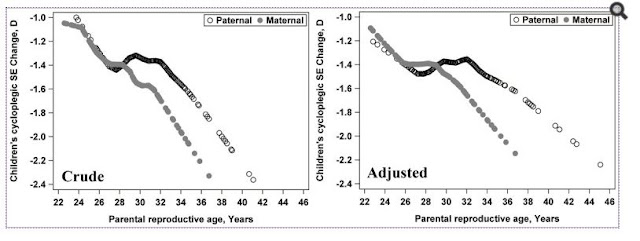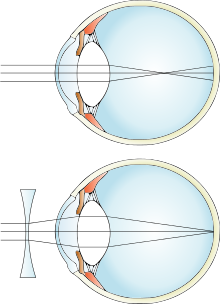Causes and potential prevention of progressive childhood myopia
 |
| Future retired biologist in her first glasses, circa mid 1980's |
Like approximately a third of Americans, I developed myopia as a kid. I don't have exact records, but it got progressively worse throughout my childhood and then stabilized when I stopped growing. That is a pretty standard experience for American myopes.
Myopia appears to have a strong genetic component. That is, whether or not your parents are myopic is a stronger predictor of whether or not you will have myopia than is time spent doing near work (reading, doing homework). There is clearly also an environmental component. Rates of myopia have been increasing much faster than genes can change, and within a given country, myopia is higher in urban areas than in the countryside. This has been studied recently in parts of Asia that have seen increases in childhood myopia correlate with urbanization:
 |
| source |
Note that rates of myopia in Taiwan are far higher than for the US -- 80% by the age of 18. We really don't know whether this is genetic or environmental. Asian-Americans kids do have higher rates of myopia than the general US population, but not as high as in Asia, so maybe some of both. An NPR story about myopia in Chinese kids reported that parents think that the problem is screen time, whereas a Chinese ophthalmologist blames to much school work. A number of studies have been done to attempt to correlate near work with myopia and/or time spend outdoors with the lack of myopia. Some of these studies do find a small effect, but it's a lot less than I would have expected. There is actually a stronger association with parental age than with near work:
 |
| Source |
There is also a correlation with nighttime light exposure. Children who slept in a totally dark room had the least myopia; a nightlight correlated with increased risk of myopia; sleeping with a room light on correlated with the highest rates of myopia.
 |
| Source |
This might explain the correlation between myopia and urbanization. A quick glance at an image of the US at night shows the extent of light pollution in urban areas.
 |
| Source: NASA |
The most extensively used animal model of childhood myopia is the chicken, and we know that chicks exposed to diffuse low light develop myopia, whereas those exposed to total darkness do not. Also, in case you are now wondering what a chick wearing glasses looks like, here you go:
 |
| Source |
An interesting study that looked at multiple factors found that short sleep (less than 7 hrs vs 9+ hrs) in kids correlated with myopia. Kids that studied 10+ hours a day, compared to 6 hrs or less, also had more myopia, but once you correct for the effect of studying for 10 hours a day on sleep patterns, there was only a small effect left for study time. This suggests that the problem might not be so much screen time and study time itself, as the lack of sleep caused by too much screen and study time. Certainly we've all experienced the feeling of being bleary-eyed from lack of sleep. This same study found that kids that tend to hold reading material close to their face tend to develop more myopia. Time spent on either sports or computer use had no correlation with myopia.
Part of the genetic component is likely a predisposition to grow a longer eyeball. Myopes have a focus point in front of their retina like so:
The lower image shows the effect of a negative (concave) lens on the focal point. Kids who eventually become myopic have longer eyeballs even before they become myopic. Obviously this means that eye length is not the only factor in the development of myopia. A scatter plot of eye length vs eye diopter shows a pretty large variation in eye length for a given amount of myopia:
People with no refractive error (normal vision) have eyes that range from about 22 to 25 mm. Other factors besides eye length include the shape of the cornea (some studies find that myopes have flatter corneas) and the thickness of the ciliary body (some myopes have thicker ciliary bodies)
The ciliary body is hard to depict in pictures, but this one is about as good as it gets:
The ciliary body is a ring of tissue that surrounds the lens, which is situated just behind the iris and pupil (which is a hole in the iris). It has two functions, both of which have been implicated in myopia. One is that it drains excess fluid out of the eyeball, preventing excess pressure from building up in the eye. You don't want your eye to inflate like a water balloon. Pressure can damage the retina and cause glaucoma. That puff of air that your optometrist shoots at your eye measures pressure in the eye. As much as I hate that puff and my eyes water just thinking about it, I still go to the optometrist partially to make sure I don't have eye hypertension.
There is a correlation between eye pressure and myopia, and there is some debate in the literature about whether mild high pressure might cause myopia. If you overinflate the eyeball, it will be too long, throwing your focus off in a myopic direction. It is possible that the thicker ciliary bodies in some myopes have a harder time draining fluid.
The other function of the ciliary body (and the one that gets talked about more) is to adjust the power of the lens. If the ring of the ciliary muscle in the ciliary body dilates, tiny fibers tug on the lens. It's like a trampoline in which the lens is the jumping surface (but rounded) and the fibers are all the little springs on the outside. A normal (non-myopic) eye focuses by default in the distance. If you want to focus up close, you constrict the ciliary muscle, which relaxes the tension in the fibers, allowing the lens to be fatter and have a stronger (positive, convex) power.
This is why everyone is so worried about near work. Smooth muscles are not like skeletal muscles. Enlarged skeletal muscles are generally a good thing -- you can move heavier things with them. But smooth muscles are not supposed to be enlarged (as the ciliary muscles appear to be in some myopes). Think of the smooth muscles of the airway in asthmatics. Chronic asthma causes those smooth muscles to enlarge, but this is bad because they then have a hard time dilating. And indeed, myopes appear to have reduced mobility in their ciliary muscles. So at least in some cases, myopia might be caused by the eye getting stuck in near mode (which means you can no longer see far away) like the airway of an asthmatic gets stuck in a partially constricted mode.
There actually is some thought that chronic inflammation (which is the most common cause of chronic asthma) contributes to myopia. I can't find anyone who has tried treating myopic eyes with anti-inflammatory steroids, but steroids at least appear to keep myopia from coming back after corrective eye surgery. It doesn't look like anyone has thought to try to correlate asthma with myopia, but it's at least possible that myopia can be caused by something like asthma of the eye. I'm hedging a lot on this because not all myopes have an enlarged ciliary body or excess eye pressure. But it could be a factor for some people.
One of the more interesting observations out there is that atropine eye drops, which paralyze the ciliary muscle (and also the iris) slow the progression of myopia in children. The ATOM2 (atropine for the treatment of myopia) study found that over two years, placebo-treated kids had about -1.2D of myopia progression, whereas those with low-dose atropine had about -0.5D of progression. It's not total arrest of myopia, but it's a large reduction; far larger than other studies that have given kids bifocals or just not corrected mild myopia.
 |
| Source |
It's likely that part of the reason urbanization leads to more myopia is the increased access to corrective lenses. Myopic kids who were left uncorrected had less progression of their myopia over the course of a two-year study, as compared to kids who got glasses. The effect is small, and it's unlikely to be the whole story, but over time it could add up.
The standard explanation for why glasses make myopia worse is that if you wear them for close work, your eye gets stuck in "near mode" and can't focus in the distance. This means that you need stronger negative lenses to see in the distance, which are even worse for near work, which creates a vicious cycle. My quibble with this explanation is that even kids who wear bifocals or go without correction still have some myopia progression. So overcorrection can't really be the whole story. But it can easily be part of it.
So if you want to prevent or slow myopia in your kids, how might you do that? Atropine eye drops are available, but it's still an off-label use, and I'd be hesitant to drug a kid without more data, especially for something not life threatening. Plausible interventions based on the above are:
- Reduce nighttime light exposure in young children. Put up blackout curtains and don't leave a night-light on.
- Make sure your kids are getting enough sleep. Seven hours is not enough. If your kids are anything like I was as a kid, they will try to read under the covers at night instead of sleeping. I had to use a flashlight. Think how easy it would be with a screen.
- Don't let your kids hold their screens or books right up to their faces.
- While near work (reading, screen, homework) doesn't have a huge effect, it does have some. Ten hours a day of homework is too much anyway. So don't let them go crazy with near work.
- If your kids do need glasses, make sure they're not overcorrected. It's better to be a little on the undercorrected side. And if they can see without the glasses for near work, it's best to take them off for reading, screen time, etc.





Very good, comprehensive analysis - would like to see more research into this topic. It seems like we don't really know which ones are the most important. Even natural vision improvement practitioners really don't do a good job of controlling variables (most of them not being scientists), so even when people improve their vision using their techniques it's hard to say what actually caused the change.
ReplyDelete